
- Text by Sarah Warne-Furtado for Eurodressage - Photos © Rui Pedro Godinho
“Open the frame”, “take your time”, “the more he opens in the front the more he is able to step through from behind”, and “transitions are life!”. These were the common themes at the three-day clinic in Portugal with Olympic Gold Medalist and head trainer of the German dressage team, Monica Theodorescu.
Hosted at Gonçalo Miranda's Beloura Horse Centre on Saturday 6 September 2025, the clinic was organised by event manager Pedro Matos and made possible through the invitation of FEI committee member and 4-star judge Federico Pinteus.
The goal was to showcase and celebrate good training. “Everyone was invited to come and watch and learn from one of the best dressage trainers in the world,” said Matos. “Our hope is to grow on this, and generate more interest and support for the sport of dressage and good quality training.”
A great opportunity for dressage enthusiasts, the clinic welcomed Olympic riders as well as some rising talents from Portugal. The door was open to anyone who wanted to come along and take in the advice from this renowned rider and trainer, myself included.
“The riders chosen were those linked to sponsors who support events in Portugal, this way we are giving something back,” Matos explained.
“Transitions are life”
A major theme throughout the clinic was transitions and Monica would instruct riders to “take the energy from the hind leg with them” into the transition. This was particularly useful when moving from piaffe to passage, when the energy created in the piaffe was used to move forward into the transition to passage.
“Use the energy."
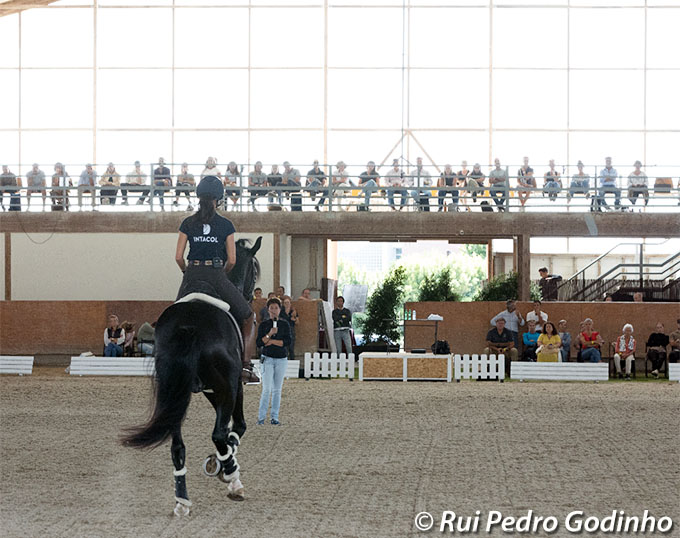
“Little half halt, quarter halt, to lift him up, now use the energy from the hind leg.”
In the transition out of the more difficult movements into a loose trot to let the horse stretch, Monica stressed the importance of not letting the horse increase the rhythm.
“Don’t chase him, he is running a little bit, he should learn that is bad.”
“The weight aid is your balance aid, it is the most important!”
Constantly reinforcing riders that the rein aid needs to be very subtle and soft, Monica would remind them not to rely too much on the reins, “quiet hands”, “don’t pull left and right, let your hands carry”, “release your hands”.
“The weight aid (seat) is your balance aid and it is the most important aid. Secondly, your leg aid, which is your driving aid, and finally the rein aid, this is your least important aid!”
Every movement she would remind riders where their weight should be and to keep the hands forward and soft.
“Sit to the left in the left half pass. Sit to where you want to go.”
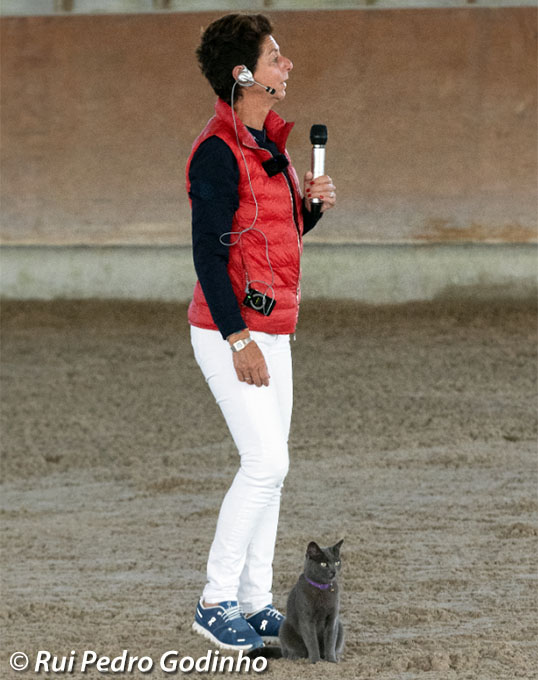
The legs, Monica advised, must be used like the hands, with a release to follow. “The legs cannot be pressing all the time. If he is not listening then give him an impulse, then release it!”
Finally the rein aid. It was clear Monica wanted the rein aid to be far less busy, and advised riders to “not control everything with the rein!”
“Leave him a little (in front), open the frame, see the stride straight away gets bigger and more uphill. The more you allow him to open in front, the more short he gets behind the saddle, and the better he can step through from behind.”
This point was well demonstrated when a rider was asked to complete the tempi changes with both reins in one hand, to not rely on the rein aid, and the changes were instantly far more fluid and engaged.
“See, so much better. Much straighter. Now he has space and is able to use the hind leg. He is out and up and in a much better frame.”
“No pressure, just consequence"
When a horse would enter the arena and show signs of fear or a lack of confidence Monica would keep the horse in the area where he was tense, but release the pressure. In this way the horse had the consequence of staying in the place he wasn’t comfortable, but with no pressure or force from the rider.
“No pressure, just consequence. Yes release the legs, keep him there. Let him look.”
She asked the rider to do small figure of 8 trot circles near the end he was afraid of, in this way working on the suppleness of the horse but also keeping him in the situation.
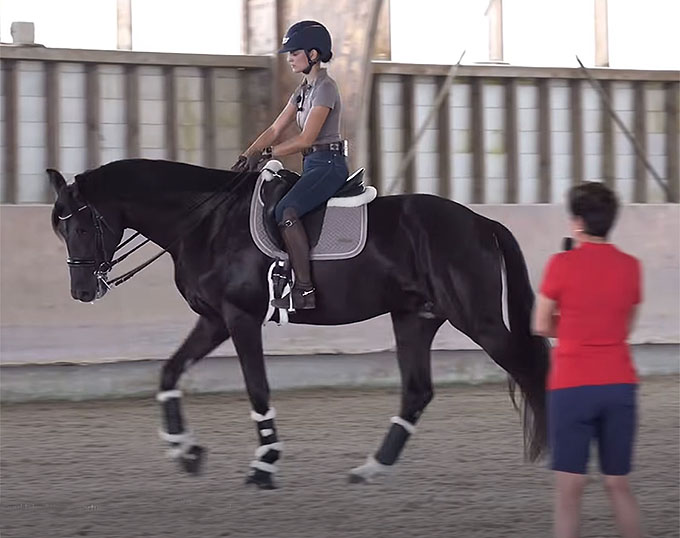
She advised riders to not move on, as without this trust nothing else can be gained.
“We will stay here as long as it takes for him to relax. We stay in it until he releases.“
“Pat on the side of danger”, was also an effective tip, as our tendency is always to pat on the inside, but if the horse is afraid of something on the outside of him, when we pat on the outside we keep our inside rein, and our flexion to the inside steady.
She talked about the compromise between keeping the horse concentrating but not stopping him looking altogether.
“He can look as long as he works with you. If you are always avoiding that he looks he won’t like it.”
Tips for exercises
Canter pirouette
Monica was again focused on the position of the rider and how their weight could bring the shoulder around, “keep the inside shoulder back, push into the inside stirrup, sit to the left, outside shoulder forward.”
She would again remind riders to half halt into the outside rein and keep the outside connection.
“Outside rein, not too much flexion. Outside rein and wait, outside rein, keep him up.Outside rein half halt.”
Time changes
“Outside rein doing small half halt as you ask for the change”, to balance and prepare, then “wait in between the changes”.
For riders using too strong an aid Monica corrected them: “keep your toes pointing forward so not so strong with the spur.”
In the canter “not so much movement with your upper body, and elbows close to your body so you don’t outstretch your arms”. “Belly button forward”.
Leg Yield
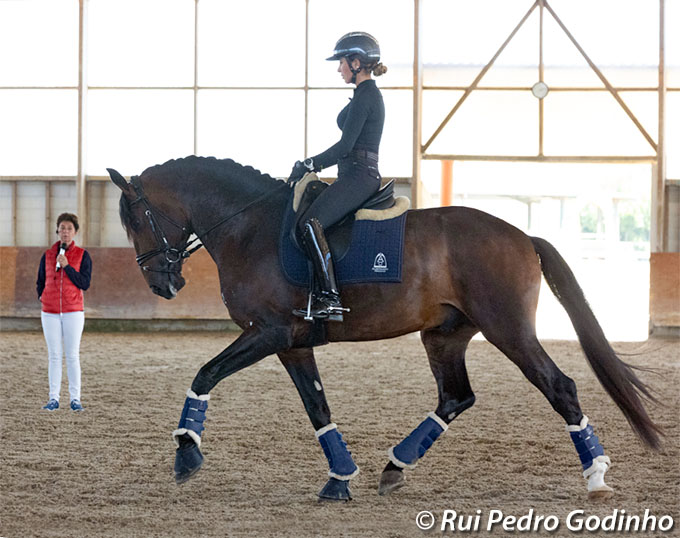
Half Pass and Zig Zag
In the half pass sit to where you want to go, ease your inside hand, and in the zig zag always “bring him up” in front, she wanted riders to take their time with the movement.
“This is not slalom.”
Passage to piaffe
“Use the energy from the hind leg” to go forward. If the horse was having trouble coming out of the piaffe she would advise riders to shorten the amount of steps, i.e 4 steps piaffe, 4 steps passage, so that the horse was always thinking forward.
10 metre volte
Be careful not to “lose the hind legs, like a bus” but to connect the outside of the horse. “Don’t flex too much and lose the hind end”. “Better to make the circle bigger” than to lose the straightness.
“Take your time”
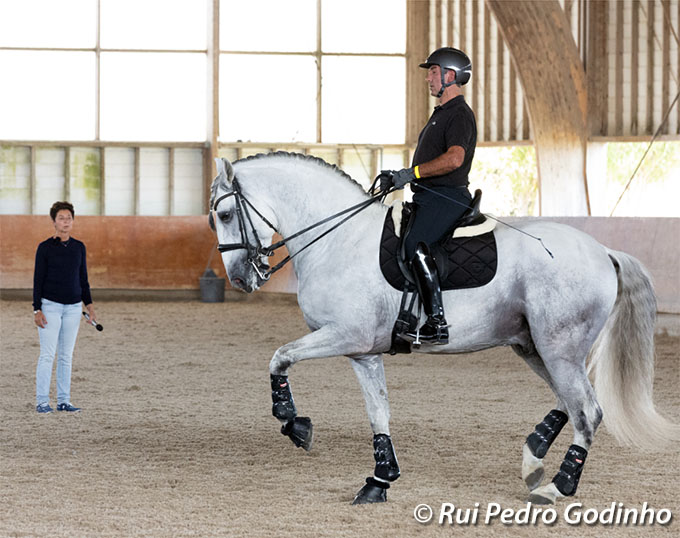
Keeping the horse straight by ”connecting the outside of the horse with the aids," and not overusing the reins or asking too much flexion.
She wanted riders to ride from the back to the front and use the energy from behind to lengthen and allow the neck to open, and to trust the horse and to keep him on your side.
“Be patient and have confidence in your horses.”
Future stars
In addition to the incredible instruction, it was a great opportunity to see some of the best riders in the country and also some of the talented horses on their way up.

Olympic rider with loads of experience, Maria Caetano, rode one of her Grand Prix stallions Horizonte (Rico out of Lepida), a charming grey Lusitano with a lot of power and talent for the Grand Prix exercises. Maria worked on transitions from piaffe and passage and it was great for the audience to see how an experienced rider develops those transitions.
Bay Lusitano Quebra-mar (Moscatel X Lanidor Plus), who competed recently at the World Young Horse Championships with Olympic rider for Mexico Mafer de Valle, are certainly a pair to watch in the future.
Rita Ralao, who made her Olympic debut in Paris, rode beautifully on 6-year old rising star Ferrero (Furstenball out of Fairy), working on the straightness and balance of this gifted horse that has huge ground coverage.
Two riders that I haven’t had the pleasure of watching very often but that made an impression as incredibly talented riders, were International Grand Prix rider from France Magali Hoetzel and Portuguese rider Joao Bento.
Finally, 6-year old Pagode MVL (by Lufada MVL x Guardião do Penedo) from the stud farm of Monte Velho, ridden by Joao Torrão, is an exceptionally talented horse, and another future hope for the Olympic rider.
The full list of Invited riders
Vasco Mira Godinho with Marquês dos Cedros
Nuno Chaves de Almeida with Nogá
Magali Hoetzel with Minuto DR
Yvonne Losos de Muñiz with Idwinaretto
Rita Ralão Duarte with Ferrero
Coralie Baldrey with Odin
Bernardo Neves with Rieta MVL
Daniel Pinto with Licor de Toula and Napoleao
João Torrão with Pagode MVL
Nicky Van Best with First Welttanzer
Martha Fernanda Del Valle with Quebra-Mar
João Bento with Poker da Lagoalva
Maria Caetano with Horizonte
Pedro Castro Monteiro with Manolete
Related Links
Monica Theodorescu: "Younger Horses with Bigger Perspective for Future Championships"
Monica Theodorescu Clinics for French FEI Riders
Monica Theodorescu: "Also Judges Should Be Sanctioned"
Monica Theodorescu: Backed by History, Facing the Present on Home Bred Horses